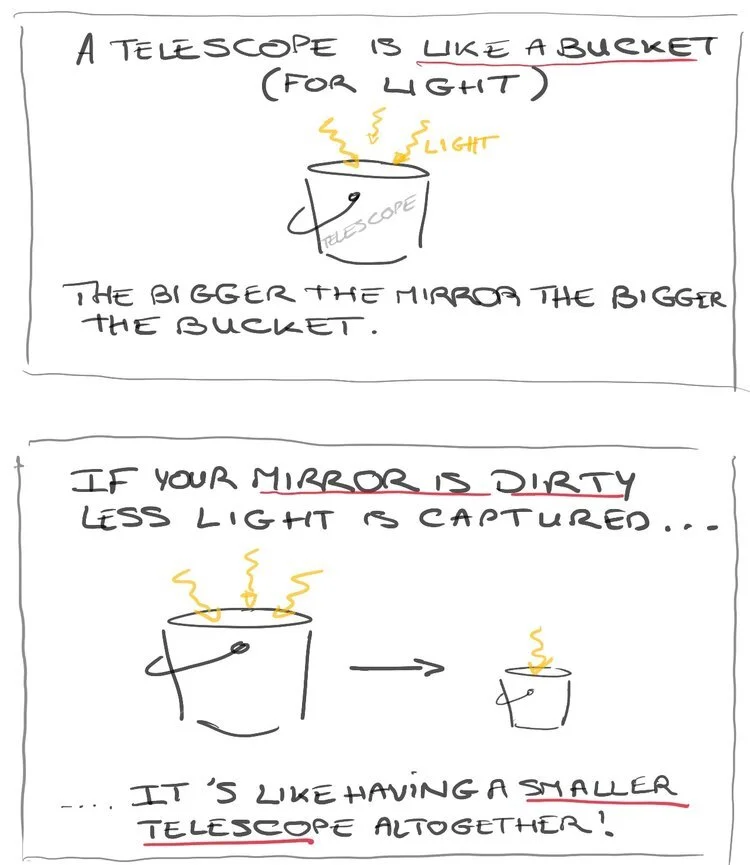What Shampoo Should I Use To Clean My Telescope Mirror?
If you’ve ever met me I might have told you about that time I helped clean a telescope mirror with “horse shampoo” (my boss’ words). Here it is with extra details and pictures!
Why clean a telescope mirror?
Before talking about how we cleaned a telescope mirror, you might be wondering why we would do this in the first place. Most telescopes stay in use for decades: The 8.2m Very Large Telescope at ESO, saw its first light in 1998 [1]; the Isaac Newton Telescope was inaugurated in 1967 [2]!
A major component of modern telescopes is their mirror (or mirrors): they focus the light so that we can collect it and do science with it. A telescope is like a bucket we use to catch as much light as possible: the bigger the mirror of the telescope, the bigger the bucket.
The problem is, mirrors get dirty, and a dirty mirror doesn’t reflect as much light as a clean one. In practice, having a really unkempt mirror is equivalent to having a smaller bucket…. I mean telescope.
So what do you do if you’re mirror is nasty? In some cases, mirrors (or mirror segments) are re-aluminised, which is the brute-force method of entirely removing the aluminium coating (the shiny part) off the glass/ceramic base, and then re-applying a thin film of fresh aluminium.
In short, it goes something like this…
In practice, though, it is very complex. Just to name a few major hurdles: You first need to remove your mirror form your telescope, but these weigh literal tonnes; you need to move your mirror to the facility where the vacuum chamber is located; you need to strip the mirror off of any coating before coating it anew.
This last part is not only tedious, it can actually ruin your telescope: the shape of a mirror is absolutely paramount… so you better not scratch it.
But you don’t necessarily need to re-coat your mirror to make it shine again...
Cleaning the Isaac Newton Telescope
The Isaac Newton Telescope is a big beast: It’s primary (i.e. biggest) mirror is 2.5 meters across and weighs over 4 (metric) tonnes. On top of that, the re-aluminisation chamber is in the building of another telescope, so transportation is no easy feat.
The good news is that we don’t necessarily have to go through that process. Instead, we can just give it a good wash with some water and soap!
Obviously, even this is a delicate process: like I said, the shape of a mirror is crucial to produce quality images. On top of that, there is a lot of electronics in a telescope, and as we know, mixing electronics and water can yield… shocking results.
So in short, to clean your INT, you will need:
1) A plastic tarp: to protect your telescope from water.
In these picture your can see the plastic sheet covering up the bottom half of the mirror mount.
2) The so called “Horse shampoo”: ORVUS paste. It is used to clean live-stock as well as historical linens [3],[4]. It is super concentrated but not harsh! Remember our mirror is very delicate, and you can’t just use any type of soap. They might be too abrasive or leave residue (bad for reflectivity).
3) Natural sponges: because they are soft and less likely to scratch the mirror. To make sure we don’t damage the reflective coating, we lightly dab the soapy sponges: NO RUBBING!
4) Deionized water: to mix your soap into, and rinse your mirror afterwards
5) And finally, pressurised CO2 to dry the mirror! I don’t have a picture for that, just imagine a hose that spews pressurised air.
After this process, we tested the reflectivity in multiple wavelengths, and in a few cases we even got a better reading than the benchmark!
I would call that a win ;)
Here is a before and after:
Note: Every few years, the INT does get treated to a re-aluminisation, but this process reduces the need for this frequency of this intensive procedure.









